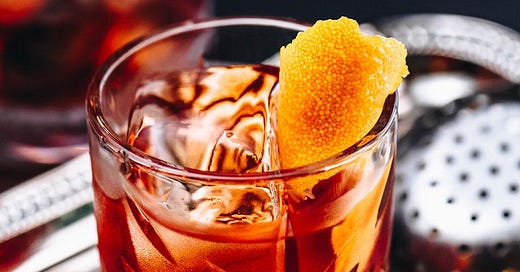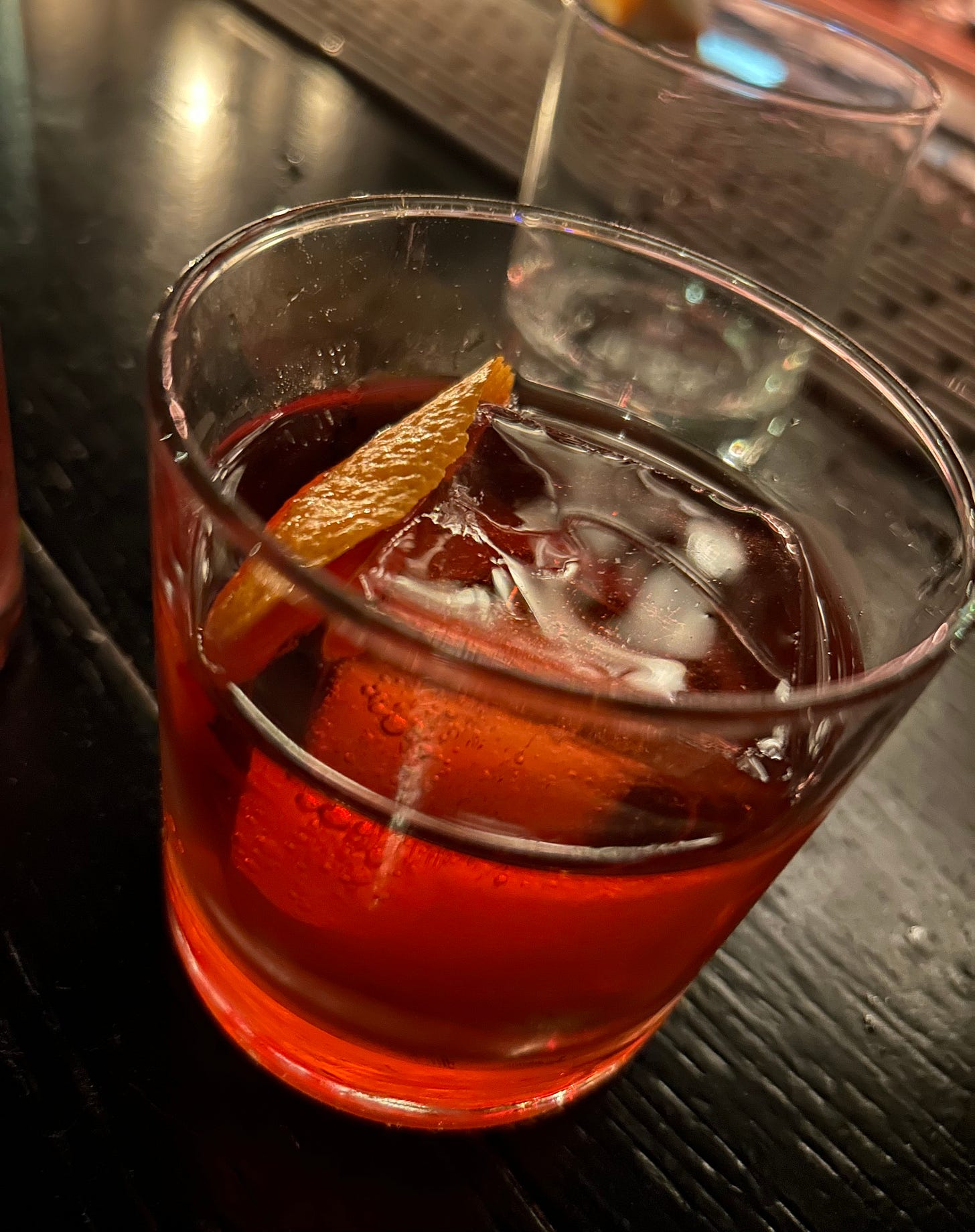I recently lamented to my good friend, Mark, “Man, that’s a hard cocktail to like.”.
I was talking about the Negroni.
“Yeah”, he replied. “It’s the fucking Campari.”
Now, I know that millions of you out there worship at the alter of the Negroni, so please, before you light up your flamethrowers, read on.
I don’t want to dislike the Negroni, I really don’t. In fact, I’m trying very hard to make a good one, as my partner is really a fan of this drink. I’ve made her a few now and she’s always very complimentary, telling me that she really likes them.
I think they suck.
One of us is probably right, although it’s really hard to tell who it is. Maybe (hopefully) the truth is somewhere in the middle.
The Negroni is unique in that it’s the only cocktail I’m aware of that has its own period of time. I’m talking about Negroni week, and we are not that far out from the recently concluded Negroni week 2024, which ran from September 16th through the 22nd. Heavily marketed by both Campari and Imbibe magazine, Negroni week has been around since 2013. It’s touted as “a celebration of one of the world’s great cocktails and an effort to raise money for charitable causes around the world.”. Seems like a good deal all the way around.
As long as you like a Negroni, which, as I said before, is hard. At least it is for me.
The classic Negroni is an equal-parts build of three ingredients: gin, sweet vermouth and, you guessed it Campari. An ounce of each, poured into a mixing vessel and stirred with ice until it’s really cold, strained into a rocks glass with a large chunk of ice, and garnished with some type of orange: a peel expressed and placed in the glass, an orange wedge, an orange wheel. You get the idea. Seems pretty straightforward, like it should be easy to make a good one.
Negative, ghost rider.
If you break down the individual ingredients, there’s a lot going on here. The juniper-forward botanicals of the gin, the herbal qualities contributed by the vermouth and the ripping bitterness of the Campari combine to form, depending on who you ask, a well-balanced, herbal cocktail with a slightly bitter aftertaste, or, bluntly, liquid pain.
The story of the Negroni is widely considered to be this: Italian Count (What’s a Count, you ask? Find out here, but you might be surprised to learn that the county you live in, if you’re reading this in a place that has counties, might have been administered by a Count if you were reading this a few centuries ago in certain places in Europe.). Anyway - Italian Count with the last name of Negroni walks into a bar. It’s not a joke. Dude walks into a bar, after a particularly hard day Counting, and asks for his normal cocktail, an Americano, only stronger. Apparently the barman substituted gin for the soda normally found in the Americano and, wham! Now we have Negroni week.
I did, one time, try a Negroni that I thought was really pretty good. On the way home from a trip to Montreal, my partner and I detoured to Lake Placid, NY for a night. After dinner we found a place called Top of the Park, a second-story cocktail joint with a spectacular view of Mirror Lake and bartenders who are serious about their craft. I had my normal Old Fashioned, and she had a Negroni. I tried it and was very pleasantly surprised at how good it was. Very well balanced, with a hint of bitterness at the end. I’d drink that.
Unfortunately, I neglected to ask the barkeep how he made it, an omission that I’m still kicking myself for to this day. Ever try to kick yourself? It’s pretty hard. You have to really want it.
After giving the matter some deep consideration, I decided the only way to address this shortcoming was more in-person research. I needed to go someplace and get a good Negroni. The place I chose was the joint that is rapidly becoming my favorite bar in Rochester - The Revelry. I recently had a very good Sazerac at this bar and knew that the bartenders there were on their game. Given that the Negroni is one of the most popular cocktails in the world, I figured they had probably made a few.
We arrived and made our way into the bar. It was pretty busy already but my partner has the uncanny ability to find space at a bar, and she noticed that there was a couple getting ready to leave. We moved like thirsty ninjas, sliding into the spot that was vacated only seconds before, and settled in.
A few short moments later the bartender came over and asked what we would like. I replied, “we’d like two Negroni’s, please.”. He was a really nice guy and clearly a bartender who wanted to provide us with a good experience, so we talked a little bit about gin. He ran through the list of options, and I decided to give Ford’s a go. He was nice enough to pour me a small sample. I nosed it and tasted it, very juniper forward, bright and clean. I decided to stick with it. My date, on the other hand, thought it would be good to be able to make an A/B comparison, since we were doing highly scientific research, and not just having a drink. The bartender suggested Roku, the Japanese gin, not the streaming service. He explained that Roku gin is his favorite for this drink, so she went with that one. He also asked about vermouth preference, and we decided to use Carpano Antica in both drinks.
The two seats we had found were directly in front of the mixing station, so I watched closely while our drinks were made, chatting with the bartender about my struggles with making this particular cocktail. He agreed that this one can be a bit tricky. I watched as he carefully measured the ingredients and added ice to both mixing vessels. Then he stirred. And stirred, and then stirred more. I’m guessing he stirred these drinks for at least a minute, and I suddenly realized that’s probably where my concoctions go off the rails. I said as much and he agreed, saying that this cocktail needs the proper dilution and to be served ice-cold. Most people new to making the drink don’t stir it long enough.
He pulled two double Old Fashioned glasses from behind the bar and set a large rock of fresh ice in each, then strained our drinks into the glasses. Expertly pulling two garnishes of orange peel, he then flamed the expressed citrus oil over our cocktails, placed the orange twist in the drink and presented them to us.
It was time. I sipped.
It was…
Good. Really good. Ice cold, with a balance of sweet vermouth and botanical gin that quickly gave way to the bitterness of the Campari on the finish.
Then I tried my parner’s version. It was spectacular! Noticeably more three-dimensional than mine, complex, bright, light, sweet and bitter. I can see why our bartender really enjoys this gin. My Negroni, made with Ford’s was very enjoyable, but the Roku gin-based drink that my partner had was next-level.
We sat and enjoyed our drinks, chatting with the bartender about Campari cocktails, the origin of the Negroni, and another of his favorite drinks, vermouth and soda. Eventually he had to move on, and we compared our two cocktails a bit more as we finished them up. While the temptation of ordering another was palpable, we decided to call it a night at one, settled up, and headed home, our research complete.
The next step is, obviously, to try to replicate the results, just like any good scientist conducting serious research would.
More to come on that…






